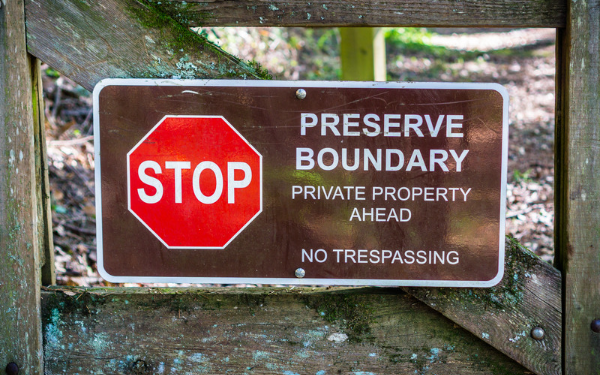Saying No, With Love
By Corinne Farago

It’s a romantic myth that good relationships don’t require setting boundaries. In fact, healthy relationships depend on setting and respecting boundaries.
Boundaries are an essential part of any healthy relationship. They help to establish a framework of mutual respect, safety, and trust.
When we don’t set clear boundaries or communicate our desires and expectations, our partner may not know how to meet our needs or may not even be aware that they are not meeting our expectations. This can lead to feelings of disappointment and resentment, as we may feel like our needs are not being prioritized or valued.
Without boundaries, relationships can become unbalanced, leaving one partner feeling overwhelmed or resentful.
Setting boundaries doesn’t mean that we don’t love or trust our partner; rather, it means that we value ourselves and our relationship enough to ensure that both partners are honored and respected.
This mean that both partners communicate their needs and expectations clearly. They’re willing to listen and compromise when necessary. By working together to establish and maintain boundaries, partners can create a relationship that is based on mutual respect, trust, and love.
How do we say no, with love?
Most of the conversations around boundaries these days focus on protecting ourselves from narcissists, gas-lighters, or toxic relationships that need to end, but how do we set boundaries with those we love?
Without love and compassion, setting boundaries can feel like a rejection or criticism, which can lead to conflict and resentment.
However, when we communicate love in the process of setting boundaries, we create a space for open and honest communication, where both partners can express their needs and expectations without fear of judgment or rejection.
When we communicate love in the process of setting boundaries, we demonstrate to our partner that we care about their feelings and well-being, and that we are committed to maintaining a healthy and loving relationship.
Communicating love when setting boundaries helps to reinforce the positive aspects of the relationship and to build trust and intimacy. When we demonstrate that we care about our partner’s feelings and well-being, we create a safe and supportive environment where both partners can thrive and grow together.
The next time you need to set a boundary with your partner, keep these things in mind:
- Don’t bark out your boundary when you’re in a triggered state. Wait until you’re calm and set aside a time to sit down and talk about your needs.
- Say it with love. Help your partner feel loved and appreciated as you set your boundary. Help them feel that your boundary is not a form of punishment or payback, but is rather a healthy conversation about maintaining autonomy, trust, and connection.
- Make clear agreements so your partner understands your needs and knows how to meet them. Think about what you want out of that conversation beforehand, and work together to establish what those new agreements might be.
- Remember that relationships aren’t rigid. Nothing is written in stone. As things evolve new agreements can always be suggested in the future. Acknowledge that agreements are honored so trust can be built.
Lastly, listen to your gut.
Boundaries are an important part of caring for ourselves. They allow us to prioritize our own needs and well-being.
Learn to recognize your own boundaries. Your body is the first place you’ll feel a boundary being crossed. If your gut is clenched, if your throat is tense, your body is asking you to pay attention.
Reach out for help if you want to learn more about setting boundaries with love for yourself, and love for others.
Private coaching is your fastest route to forming long lasting habits that create loving relationships.
If your relationship is struggling with conflict, or suffering from a lack of connection, schedule a a free discovery Call with me.
You’ll learn how relationship coaching can lay a solid foundation for your future happiness.

Examine Your Core Beliefs and Reach New Levels of Intimacy
By engaging in honest self-reflection and exploring the source of our stories, we can better understand ourselves and improve relationships by approaching conversations with clarity instead of fear or judgement. By owning up to what we’re telling ourselves and actively listening to our inner dialogue, we can unravel distorted thinking and create healthier connections with those around us.
9 Reasons Why Couples Work With a Relationship Coach
I love my couples. They reach out for sex coaching, wanting to create a fulfilling sexual and intimate life. The number one obstacle to achieving their goals is sometimes an unhealthy relationship dynamic. For most of us, opening ourselves to sexuality with our partners requires trust, connection and a sense of emotional safety. If our relationships are being impacted by unhealthy dynamics that leave us triggered and harboring conscious or unconscious resentment, sexuality will be impacted or, at worst no longer exist.
Sexual Trauma and PTSD
Sexual Trauma and PTSD keep painful memories from our past alive and present in our day to day lives. Hypnotherapy uses the power of your own mind to unlock the hold these memories have on you, by helping your brain process them in a gentle and effective way. If you suffer from trauma, you’re well aware that some memories trigger feelings of present-time fear, keeping you anxious, and on high alert, even though consciously you know you’re no longer in danger. If some of those memories have created Post Traumatic Stress Disorder that means your brain is ‘matching’ those past memories to present day experiences, or what is referred to as ‘pattern matching’ in Hypnotherapy.
New Ways to Heal Old Wounds
When two people get together to form a relationship, there are two sets of wounds merging and intertwining, our partner’s and our own. We know when our old wounds are being dragged into a conflict because our pain and defensiveness will suddenly spike. If our partner is speaking the same words as our inner abuser, the armor will go up, and disagreements will escalate into shouting, tearful battles.





